|
|
|
|
|
|
|
|
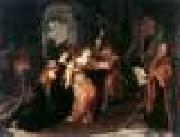 |
COYPEL, Antoine
|
|
French Baroque Era Painter, 1661-1722
director of the French Royal Academy and principal painter of Louis XV. He illustrated many literary works, including editions of Moliere's plays, and was himself a prolific dramatist. Coypel wrote one fairy tale, Agla ou Nabotine (Agla or Little One?), published posthumously in 1779. Coypel weaves several traditional fairy tale motifs into the story of a benevolent fairy who tests the kindness and sincerity of an ugly little girl whose virtue is eventually rewarded with beauty and the love of a handsome young man.
|
|
|
|
 |
COYPEL, Noel Nicolas
|
|
French painter (b. 1690, Paris, d. 1734, Paris)
was a popular French artist. The son of Noël Coypel and half-brother to the more-famous painter Antoine Coypel, he was accredited to the Academie Royale in 1716. He was appointed a professorship in 1733
|
|
|
|
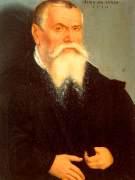 |
CRANACH, Lucas the Elder
|
|
German painter (b. 1472, Kronach, d. 1553, Weimar).
German painter and engraver. The son of a painter, he settled in Wittenberg c.1504 and was court painter successively under three electors of Saxony. There he maintained a flourishing workshop and was twice burgomaster. Cranach was a close friend of Martin Luther, whose doctrine he upheld in numerous paintings and woodcuts, and he has been called the painter of the Reformation. He was a rapid and prolific painter, and the work turned out by his studio is uneven in quality. Naïve and fanciful, often awkward in draftsmanship, it has, nonetheless, freshness and originality and a warm, rich palette. His portraits are particularly successful. Among his best-known works are Repose in Egypt (Gemäldgalerie, Staatliche Mus., Berlin-Dahlem); Judgment of Paris (Staatliche Kunsthalle, Karlsruhe); Adam and Eve (Courtauld Inst., London); and Crucifixion (Weimar). The latter contains figures of Luther and Cranach. His many famous protraits include those of Elector John Frederick and Self-Portrait (Uffizi). Cranach was also an accomplished miniaturist. He produced a few copperplates and designs for woodcuts. His son and pupil Lucas Cranach, the Younger, 1515C86, |
|
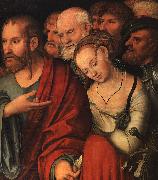 |
CRANACH, Lucas the Younger
|
|
German painter (b. 1515, Wittenberg, d.1586, Weimar)
was a German Renaissance artist, known for his woodcuts and paintings. He was a son of Lucas Cranach the Elder who began his career as an apprentice in his father's workshop. Henceforth, his own reputation and fame grew. After his father's death, he assumed control over the workshop. The style of their paintings can be so similar that there have been some difficulties in attribution of their works. |
|
 |
Crane, Walter
|
|
English Golden Age Illustrator, 1845-1915
English painter, illustrator, designer, writer and teacher. He showed artistic inclinations as a boy and was encouraged to draw by his father, the portrait painter and miniaturist Thomas Crane (1808-59). A series of illustrations to Tennyson's The Lady of Shalott (Cambridge, MA, Harvard U., Houghton Lib.) was shown first to Ruskin, who praised the use of colour, and then to the engraver William James Linton, to whom Crane was apprenticed in 1859. From 1859 to 1862 Crane learnt a technique of exact and economical draughtsmanship on woodblocks. |
|
|
|
|
|
 |
Creator:Edmond Dyonnet
|
|
He was born on 25 June 1859 in Crest (Drôme), France, from the marriage of Ulysses-Alexandre Dyonnet, industrialist, and Goullioud Albine. The real family name is Guyonnet de Pivat but due to an error of births during the French Revolution, the surname became Dyonnet. Edmond died in Montreal on 7 July 1954, at age 95. He was buried with his family in the cemetery of Notre-Dame-des-Neiges, in Montreal.
Edmond had two younger sisters, Emma Dyonnet, wife Lorin (1866-1947) and Clemence Dyonnet, wife Chabot (18? -1905). Ulysses, the father of Edmond, had an older brother Leon Dyonnet Goullioud who married Helen, the sister of Albine. Leon Dyonnet made a fortune in corsets for women in association with Amyot from 1886 to 1891 and set up the Dominion Corset company, rue de la Couronne in Quebec City. The couple had a daughter artist, cousin of Edmond Dyonnet: Eugenie Dyonnet, who immigrated to Canada in 1872 and died in 1875 in Montreal.
Edmond Dyonnet was born in Drôme in 1859, and at 9 years old, he followed his father and migrated to Italy, he continued his primary education in Turin, from 1868 to 1873, in municipal schools and then returned to France with his family in the Drôme. He studies at Crest high school from 1873 to 1875. His father Ulysses met in Paris the brother of Judge George Baby who convinced him to emigrate to Quebec.
|
|
 |
CRESPI, Daniele
|
|
Italian Baroque Era Painter, ca.1598-1630
Italian painter and draughtsman. He was the most original artist working in Milan in the 1620s, the first to break with the wilfully exaggerated manner of Lombard Mannerism and to develop an early Baroque style, distinguished by clarity of form and content. In this context his Supper of St Carlo Borromeo is one of the most famous early 17th-century pictures in northern Italy. |
|
|
|
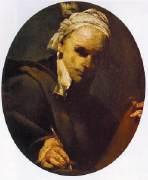 |
CRESPI, Giuseppe Maria
|
|
Italian Baroque Era Painter, 1665-1747
Painter, draughtsman and printmaker. His religious and mythological works are distinguished by a free brushstroke and a painterly manner. He also painted spirited genre scenes, which by their quality, content and quantity distinguish him as one of the first Italian painters of high standing to devote serious attention to the depiction of contemporary life. Such paintings as Woman Laundering (1700-05; St Petersburg, Hermitage) or Woman Washing Dishes (1720-25; Florence, Uffizi) offer straightforward glimpses of domestic chores in images that are startlingly novel for the period and look forward to the art of Jean-Simeon Chardin, Jean-Francois Millet and Honore Daumier. |
|
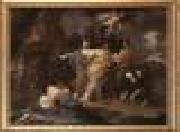 |
CRETI, Donato
|
|
Italian painter, Bolognese school (b. 1671, Bologna, d. 1749, Bologna)
Italian painter and draughtsman. His individual and poetic art represents, with that of Marcantonio Franceschini, the last significant expression of the classical-idealist strain in Bolognese painting. His activity was almost wholly confined to Bologna, where he painted decorative frescoes, altarpieces and easel pictures for private collectors. Two qualities are paramount: a perfected finesse of handling and poetic suggestiveness of situation and mood. He sought the ideal beauty of the individual figure and was thus at his best in meditative pictures with few figures; his subjects combine grace of form and precision of contour with flesh that attains the surface delicacy of porcelain and colours that have a mineral-like refulgence. |
|
 |
Cristiano Banti
|
|
Italy (Santa Croce Sull'arno 1824-Montemurlo 1904 ) - Painter |
|
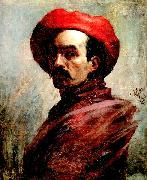 |
Cristobal Rojas
|
|
Cristobal Rojas (Cua, Miranda, 15 December 1857 e Caracas, 8 November 1890) was one of the most important and high-profile Venezuelan painters of the 19th century. Rojas's styles varied considerably throughout his life, and he displayed talents in painting that ranged primarily for dramatic effect, to works done in the Impressionist style.
Cristebal Rojas Poleo was born in the city of Cea in the Valles del Tuy to parents who worked in the medical profession. Part of his childhood occurred during the middle of the federal war (1859 - 1863) and Cea was particularly affected by the events of the war. He initiated studies under his grandfather, Jose Luis Rojas, who taught him how to draw and motivated him to improve. At 13 years old, his father died and he was forced to begin work in a tobacco factory in Cea to help support his family. In 1878, an earthquake devastated the Valles del Tuy region, and the Rojas faced poverty. As a result he moved to Caracas where he continued his painting studies, despite again having to work in the tobacco industry to support his mother and family.
In Caracas he attended classes by Jose Manuel Mauco at the Universidad Central de Venezuela. Between 1880 and 1882, he developed a keen interest in oils and displayed a primitive technique that would prevail in his later paintings such as Ruinas de Cea despues del Terremoto and Ruinas del templo de la Merced. During this time he became acquainted with the painter Antonio Herrera Toro, also coming under contract as Toro's assistant to paint Caracas Cathedral.
|
|
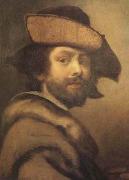 |
Cristofano Allori
|
|
Italian Baroque Era Painter, 1577-1621
was an Italian portrait painter of the late Florentine Mannerist school. Allori was born at Florence and received his first lessons in painting from his father, Alessandro Allori, but becoming dissatisfied with the hard anatomical drawing and cold coloring of the latter, he entered the studio of Gregorio Pagani (1558-1605) who was one of the leaders of the late Florentine school, which sought to unite the rich coloring of the Venetians with the Florentine attention to drawing. Allori also appears to have worked under Cigoli. His pictures are distinguished by their close adherence to nature and the delicacy and technical perfection of their execution. His technical skill is shown by the fact that several copies he made of Correggio's works were thought to be duplicates by Correggio himself. His extreme fastidiousness limited the number of his works. Several specimens are to be seen at Florence and elsewhere. The finest of his works is his Judith with the Head of Holofernes. It exists in two copies in the Pitti Palace in Florence and in the Queen's Gallery in London. |
|
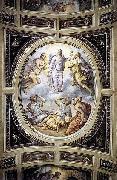 |
Cristofano Gherardi
|
|
(November 25, 1508 - April 1556) was an Italian painter of the late-Renaissance or Mannerist period, active mainly in Florence and Tuscany.
He was born in Borgo San Sepolcro and also called il Doceno dal Borgo. He was the pupil of the painter Raffaellino del Colle, in whose shop he encountered Rosso Fiorentino and Giorgio Vasari. He painted under Vasari's direction, the one assistant of Vasari's whom Sidney J. Freedberg singles out.
In 1536 Vasari invited him to Florence to assist in producing the decorations for the ceremonial entry of Charles V into Florence. The following year, in the reaction after Duke Alessandro's death, Gherardi was among those banished from Florence, so his work for Vasari was confined to projects outside Florence, until his banishment was lifted in 1554 and he was permitted to return . In the long interval he had painted the Visitation of Mary to Elizabeth for the church of San Domenico in Citte di Castello, church decorations in San Sepolcro, and works for the Vitelli, who were long-term patrons. Gherardi, in the two years left to him, assisted Vasari in the Quartiere degli Elementi in Palazzo Vecchio. Vasari's main assistant after Gherardi's demise was Jan van der Straat, called Giovanni Stradano.
|
|
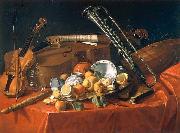 |
Cristoforo Munari
|
|
(July 21, 1667 - June 3, 1720) was an Italian painter of the late-Baroque specializing in still life paintings. He was also known as Cristofano Monari.
His initial training was in Reggio Emilia, his birthplace, and he came under the patronage of Rinaldo d'Este, Duke of Modena. In 1703-1706, he lived in Rome, then moved to Florence, where for about a decade he was attached to the court of the Medici. His still life paintings recall those of Evaristo Baschenis; however, the added disarray of porcelain, glass, and foodstuffs, suggest the hangover from the jovial surfeit of the Medici court. He painted also panoplies and war trophies. In 1715 he moved to Pisa where he worked almost exclusively in art restoration; he died in 1720.
An exhibition of his paintings took place in 1998 in Reggio Emilia, where it attracted wide attention and was a national success.
|
|
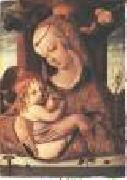 |
CRIVELLI, Carlo
|
|
Italian Early Renaissance Painter, ca.1430-1495
He produced many large, multi-partite altarpieces in which his highly charged, emotional use of line, delight in detail, decoration and citric colours, often set against a gold ground, convey an intensity of expression unequalled elsewhere in Italy. His mastery of perspective was also used for dramatic impact. As he worked in isolation in the Marches, his style only had local influence. In the 19th century, |
|
 |
CRIVELLI, Vittorio
|
|
Italian painter, Venetian school (b. ca. 1440, Venezia, d. 1501/2, Venezia) |
|
|
|
|
|
|
|
|
|
 |
CUYP, Aelbert
|
|
Dutch Baroque Era Painter, 1620-1691
Painter and draughtsman, son of (1) Jacob Cuyp. One of the most important landscape painters of 17th-century Netherlands, he combined a wide range of sources and influences, most notably in the application of lighting effects derived from Italianate painting to typical Dutch subjects. Such traditional themes as townscapes, winter scenes, cattle pieces and equestrian portraits were stylistically transformed and given new grandeur. Aelbert was virtually unknown outside his native town, and his influence in the 17th century was negligible. |
|
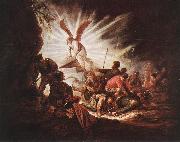 |
CUYP, Benjamin Gerritsz.
|
|
b. 1612, Dordrecht, d. 1652, Dordrecht
Dordrecht,,Painter, half-brother of Jacob Cuyp. Houbraken stated that he studied with his half-brother Jacob. Benjamin entered the Guild of St Luke on 27 January 1631, at the same time as his brother Gerrit Gerritsz. the younger. In 1641 Benjamin gave evidence in a medical affair, which has prompted speculation that he may have trained as a doctor, but in 1643 he is twice recorded in The Hague as a painter, living with other artists. |
|
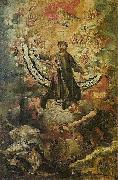 |
Cuzco School
|
|
The Cuzco School (Escuela Cuzqueña) was a Roman Catholic artistic tradition based in Cusco, Peru (the former capital of the Inca Empire) during the Colonial period, in the 16th, 17th and 18th centuries. It was not limited to Cuzco only, but spread to other cities in the Andes, as well as to present day Bolivia and Ecuador.
|
|
|
|
|
|
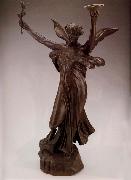 |
Daniel Chester French
|
|
American Neoclassical Sculptor, 1850-1931.was an American sculptor. His best-known work is the sculpture of a seated Abraham Lincoln at the Lincoln Memorial in Washington, D.C. French was born in Exeter, New Hampshire, to Henry Flagg French, a lawyer, Assistant US Treasury Secretary and author of a book that described the French drain. Daniel Chester French was a neighbor and friend of Ralph Waldo Emerson, and the Alcott family. His decision to pursue sculpting was influenced by Louisa May Alcott's sister May Alcott. After a year at the Massachusetts Institute of Technology, French worked on his father's farm. While visiting relatives in Brooklyn, New York City, he spent a month in the studio of John Quincy Adams Ward, then began to work on commissions, and at the age of twenty-three received from the town of Concord, Massachusetts, an order for his well-known statue The Minute Man, which was unveiled April 19, 1875 on the centenary of the Battle of Lexington and Concord. Previously French had gone to Florence, Italy, where he spent a year working with sculptor Thomas Ball. In 1917, he designed the Pulitzer Prize gold medal presented to laureates. In collaboration with Edward Clark Potter he modelled the George Washington statue, presented to France by the Daughters of the American Revolution; the General Grant in Fairmount Park, Philadelphia, and the General Joseph Hooker statue in Boston. In 1893, French was a founding member of the National Sculpture Society, and he became a member of the American Academy of Arts and Sciences. French also became a member of the National Academy of Design (1901), the American Academy of Arts and Letters, the National Sculpture Society, the Architectural League, and the Accademia di San Luca, of Rome. French was one of many sculptors who frequently employed Audrey Munson as a model. |
|
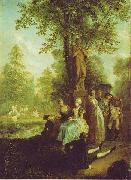 |
Daniel Chodowiecki
|
|
(16 October 1726 - 7 February 1801) was a Polish - German painter and printmaker with Huguenot ancestry, who is most famous as an etcher. He spent most of his life in Berlin, and became the director of the Berlin Academy of Art.
He was born in the city of Danzig in Poland, and in a letter in typical Berlin humor wrote, that he moved to Berlin, Germany, which shows for sure, that he is a 'genuine Pole'.[citation needed] He kept close to the Huguenot scene, due to his ancestry. A distant ancestor Bartholom us Chodowiecki had lived in the 16th century in Greater Poland . Gottfried Chodowiecki, Daniel's father, was a tradesmen in Danzig and his mother, Henriette Ayrer born in Switzerland, was a Huguenot. Daniel's grandfather Christian had been a tradesmen in the city as well. When his father died, both Daniel (aged 16) and his younger brother Gottfried Chodowiecki went to live with their uncle in Berlin, who offered to educate them, and where Daniel received an artistic training with the painter Haid in Augsburg. His brother also became a painter.
Soon Daniel was able to earn a living by painting. He was admitted to the Berlin Academy in 1764 and became vice-director under Rhode in 1788. He had found his true calling and became the most famous German graphic artist of his time. His works include several thousand etchings, usually rather small, and many drawings and paintings. He illustrated nearly all of the great classics. His prints represent in great detail the life of the middle classes during the Zopfstil period, a time between Rococo and Classicism. In 1797 Chodowiecki was appointed director of the Academy of Arts in Berlin, where he died on 7 February 1801. The bulk of his work was in illustrating scientific books by Basedow, Buffon, Lavater, Pestalozzi and others. He also painted many portraits of Polish gentry and was interested in Huguenot and Polish history as well, making some paintings on the topic. He was in tune with the developing spirit of the age, and many works reflect the cult of sensibility, and then the revolutionary and German nationalist feelings of the end of the century. |
|
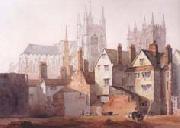 |
David Cox
|
|
David Cox [English Painter, 1783-1859]
English painter. After taking drawing lessons from Joseph Barber (1757/8-1811) in Birmingham, Cox worked briefly as an apprentice to a painter of lockets and snuff-boxes named Fieldler. This was followed about 1800 by a longer period painting scenery for the New Theatre, Birmingham. On the promise of similar employment at Astley's Amphitheatre in Lambeth, Cox travelled to London in 1804, but when this came to nothing he decided to make his name as a watercolour painter. He began exhibiting at the Royal Academy in 1805 and from 1809 until its demise in 1812 with the Associated Artists in Water-Colours, of which he became both member and president in 1810. He was elected an Associate of the Society of Painters in Water-Colours in 1812 and within a month had advanced to full membership. |
|
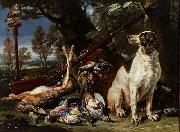 |
David de Coninck
|
|
(ca. 1644 Antwerp - after 1701, Brussels), also known as Rammelaar was a Flemish painter of the Baroque period. David Koninck was born in Antwerp and studied there under Jan Fyt. After a few years in Paris, he staid in Rome from ca 1671 to 1694, where joined the Bentvueghels with the nickname Rammelaar (rattle). He is sometimes stated to have died in Rome in 1687; however, he returned to his home country and is last recorded becoming a member of the painters guild in Brussels in 1701. His pictures are chiefly landscapes with animals and still life. He is likely unrelated to the generally contemporary Dutch painters, Philip de Koninck, or Philips Koninck (5 November 1619, Amsterdam - buried 4 October 1688, Amsterdam) and the fellow townsman Salomon de Koninck.
See Biography by Filippo Baldinucci.
|
|
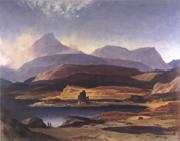 |
David Young Cameron
|
|
British master of landscape and architectural views.
Glasgow ,1865-1945
is a Scottish painter and etcher. He was trained at the Glasgow and Edinburgh Schools of Art in the 1880s. From 1887-1892 he was a member of the Royal Society of Painter-Etchers. It was during this time that he published a number of sets of etchings (such as "The Clyde Set", "The North Holland Set" and "The North Italian Set"). In general his prints feature areas of great darkness, offset by highlights. Cameron would later become known for his church interiors and barren landscapes of Scotland done in drypoint. The feathery lightness of these drypoints was in visual contrast with the rock and water of the subjects. He became highly sought after by collectors, until the Great Crash in 1929 brought a collapse in prices for prints in general. He exploited his popularity by producing an unprecedented number of states of his prints, and is believed to hold the record at twenty-eight states in one case. Cameron became a Royal Academician in 1920.
|
|
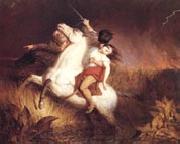 |
Deas Charles
|
|
American Painter
1818-1867
After an unsuccessful attempt to obtain an appointment at West Point Military Academy, he turned to an artistic career. He quickly earned recognition at the annual exhibitions of the National Academy of Design, New York, to which he was elected an associate member in 1839, with subjects taken from James Fenimore Cooper, |
|
|
|
|
|
|
|
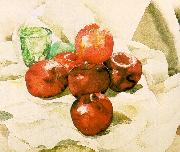 |
Demuth, Charles
|
|
American Precisionist Painter, 1883-1935
American painter and illustrator. He was deeply attached to Lancaster, where his family had run a tobacco shop since 1770. Although not a Regionalist, Demuth maintained a strongly localized sense of place, and Lancaster provided him with much of the characteristic subject-matter of both his early and later work. He trained in Philadelphia at the Drexel Institute of Art, Science and Industry (1901-5) and at the Pennsylvania Academy of the Fine Arts (1905-11), where his teachers included Thomas Anshutz, Henry McCarter (1864-1942), Hugh Breckenridge (1870-1937) and William Merritt Chase. |
|
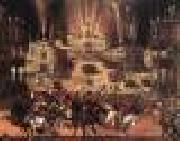 |
DERUET, Claude
|
|
French Baroque Era Painter, 1588-1660
was a famous French Baroque painter of the 17th century, from the city of Nancy. Deruet was an apprentice to Jacques Bellange, the official court painter to Charles III, Duke of Lorraine. He was in Rome between ca. 1612 and 1619, where - according to Andre Felibien - he studied with the painter and etcher Antonio Tempesta. During his stay in Rome, he painted the Japanese samurai Hasekura Tsunenaga on a visit to Europe in 1615. Deruet was made a noble by the Duke of Lorraine in 1621, and was then made a Knight of the Order of St Michel in 1645 by Louis XIII, who had in 1641 absorbed most of Lorraine into France. He had a luxurious residence in Nancy, named La Romaine, where Louis XIII and his Queen stayed in 1633. Claude Lorrain was an apprentice to Claude Deruet in 1623 for one year. |
|
|
|
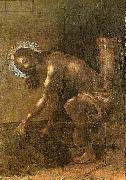 |
Diego de Carpio
|
|
painted Christ gathering his clothes after the Flagellation in 1798 |
|
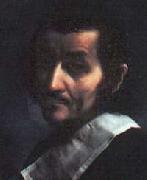 |
DOLCI, Carlo
|
|
Italian Baroque Era Painter, 1616-ca.1686
was an Italian painter of the Baroque period, active mainly in Florence, known for highly finished religious pictures, often repeated in many versions. He was born in Florence, on his mother's side the grandson of a painter. Although he was precocious and apprenticed at a young age to Jacopo Vignali, Dolci was not prolific. "He would take weeks over a single foot", according to his biographer Baldinucci.His painstaking technique made him unsuited for large-scale fresco painting. He painted chiefly sacred subjects, and his works are generally small in scale, although he made a few life-size pictures. He often repeated the same composition in several versions, and his daughter, Agnese Dolci, also made excellent copies of his works. Dolci was known for his piety. It is said that every year during Passion Week he painted a half-figure of the Saviour wearing the Crown of Thorns. In 1682, when he saw Giordano, |
|
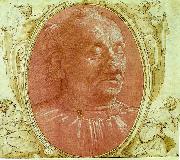 |
domenico chirlandaio
|
|
Domenico Ghirlandaio (1449 - 11 January 1494) was an Italian Renaissance painter from Florence. Among his many apprentices was Michelangelo.
Ghirlandaio's full name is given as Domenico di Tommaso di Currado di Doffo Bigordi. The occupation of his father Tommaso Bigordi and his uncle Antonio in 1451 was given as 'setaiuolo a minuto,' that is, dealers of silks and related objects in small quantities. He was the eldest of six children born to Tommaso Bigordi by his first wife Mona Antonia; of these, only Domenico and his brothers and collaborators Davide and Benedetto survived childhood. Tommaso had two more children by his second wife, also named Antonia, whom he married in 1464. Domenico's half-sister Alessandra (b. 1475) married the painter Bastiano Mainardi in 1494.
Domenico was at first apprenticed to a jeweller or a goldsmith, most likely his own father. The nickname Il Ghirlandaio (garland-maker) came to Domenico from his father, a goldsmith who was famed for creating the metallic garland-like necklaces worn by Florentine women. In his father's shop, Domenico is said to have made portraits of the passers-by, and he was eventually apprenticed to Alessio Baldovinetti to study painting and mosaic. |
|
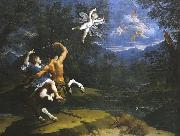 |
Donato Creti
|
|
(1671-1749) was an Italian painter of the Rococo period, active mostly in Bologna.
Born in Cremona, he moved to Bologna, where he was a pupil of Lorenzo Pasinelli. He is described by Wittkower as the "Bolognese Marco Benefial", in that his style was less decorative and edged into a more formal neoclassical style. It is an academicized grand style, that crystallizes into a manneristic neoclassicism, with crisp and frigid modeling of the figures. Among his followers were Aureliano Milani, Francesco Monti, and Ercole Graziani the Younger. Two other pupils were Domenico Maria Fratta and Giuseppe Peroni |
|
 |
Dora Carrington
|
|
British Painter,
1893-1932
English painter and decorative artist. Daughter of a Liverpool merchant, she was brought up in Bedford. She trained at the Slade School of Fine Art in London where she met John Nash, who aroused her interest in wood-engraving, and Mark Gertler, whose powerful figure paintings influenced her own approach to portraiture. She rejected Gertler as a lover and set up home with the homosexual essayist and biographer Lytton Strachey (1880-1932), first at Tidmarsh Mill, near Pangbourne, Berks, then at Ham Spray, between Newbury and Hungerford, Berks. In 1921 she married Ralph Partridge, living with him and Strachey in a m?nage ? trois, surrounded mainly by literary friends and receiving little encouragement to exhibit. She turned instead to decorative work, emulating Vanessa Bell and Duncan Grant but in a style more native in inspiration and more naive. She designed tiles and inn signs, experimented with painting on glass and tinfoil, decorated furniture and designed the library at Ham Spray. |
|
|

